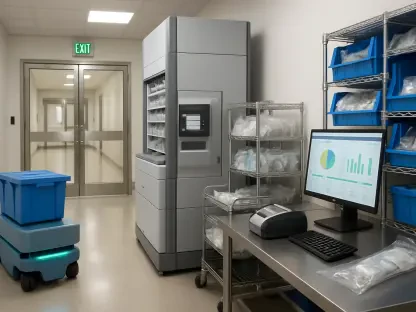Clinical trials are an essential step in the development of new medical treatments and drugs, but they often impose significant challenges on participants. Frequent visits to medical facilities, financial costs, and time away from personal and professional commitments exacerbate these challenges, especially for demographics such as the elderly, children, and physically or cognitively impaired individuals. These hurdles not only deter potential participants but also elevate dropout rates, which in turn increase recruitment costs and prolong trial durations. Addressing these difficulties is critical for both patients and pharmaceutical companies, as it fosters better experiences for participants, reduces financial pressures, and enhances the integrity and reliability of trial outcomes.
The Role of IoT in Decentralizing Clinical Trials
A key theme is the significant role IoT can play in decentralizing clinical trials, converting them into decentralized clinical trials (DCTs). By leveraging IoT, trials can minimize the need for physical visits to medical facilities through telehealth, at-home visits by healthcare professionals, and wearable devices. IoT wearables equipped with sensors gather biometric data such as heart rate, temperature, blood pressure, galvanic skin response, electrocardiogram readings, and brain activity. This data is then transmitted wirelessly to external devices where clinical researchers can analyze it, providing accurate and continuous monitoring that enhances data integrity and patient compliance.
These advancements in IoT technology offer remarkable potential for decentralizing traditional clinical trials. The elimination of frequent physical visits to clinical trial centers marks a notable shift towards convenience and accessibility, simplifying the participation process for various demographics. Furthermore, IoT enables trials to reach patients residing in remote or underserved areas, addressing geographical barriers that often limit participant recruitment. This decentralization not only reduces logistical complexities but also offers a more inclusive approach, ensuring a diverse and representative sample. Ultimately, IoT’s integration in clinical trials promises improved efficiency and heightened patient engagement, resulting in more reliable and robust trial outcomes.
Examples of IoT Wearables in Clinical Trials
Examples of IoT utilization in clinical trials include remote continuous glucose monitoring devices by Dexcom’s One+ and Abbott’s FreeStyle Libre, smartwatches used by Pfizer, and digital mobility biomarkers deployed by Novartis in knee osteoarthritis studies. Additionally, smart scales have been instrumental in obesity trials, providing precise metrics that contribute to more informed and personalized treatment approaches. These wearables exemplify how IoT can gather critical data seamlessly and non-intrusively, thereby creating a patient-centric trial environment that promotes adherence and precision.
Advanced IoT applications in clinical trials showcase the technological prowess and versatility of these solutions. For example, continuous glucose monitoring devices deliver real-time data to researchers, allowing for rapid interventions and modifications to treatment plans. Smartwatches, equipped with sophisticated sensors, provide a comprehensive suite of metrics that reveal insights into a patient’s health status, activity levels, and vital signs. Novartis’s digital mobility biomarkers in knee osteoarthritis studies demonstrate how IoT can revolutionize the monitoring of musculoskeletal conditions, giving rise to dynamic data collection and analysis. This multi-faceted utilization of IoT wearables enhances the depth and accuracy of clinical trial data, yielding superior outcomes and patient experiences.
Benefits of IoT in Parkinson’s and Huntington’s Disease Trials
Roche’s innovative digital biomarker solutions for Parkinson’s and Huntington’s disease epitomize the benefits of DCTs. These biomarkers are crucial in Parkinson’s disease management where symptoms vary significantly, making it difficult for patients to recall the severity and timing accurately. Using smartphone sensors for frequent measurements alleviates the need for constant clinical visits and collects high-quality data, thus reducing patients’ burden. These measurements include manual dexterity tasks that identify worsening disease signals such as tremors and slowed movement, facilitating timely interventions and adaptive treatment strategies.
The deployment of digital biomarkers in Parkinson’s and Huntington’s disease trials marks a significant leap in clinical research. Roche’s application of smartphone sensors offers a practical solution to capture minute-to-minute variations in symptom severity, thereby producing granular data for analysis. In Parkinson’s disease management, frequent data collection can identify trends and trigger alerts for proactive medical engagement, reducing the uncertainty and reliance on patient recall. By integrating digital mechanisms, Roche enhances the accuracy of symptom tracking and management, demonstrating how IoT can transform the landscape of chronic disease trials. These advancements reduce the physical and emotional toll on patients, endorsing a patient-centric approach that refines the clinical trial process.
Economic Advantages of DCTs
An overarching trend in adopting DCTs is the substantial reduction in dropout rates and enhanced economic outcomes. According to a paper on the NIH website, incorporating DCT methods in Phase II and Phase III trials can lead to a $20 million increase in value per drug and a seven-fold return on investment. This stems from shorter trial phases, fewer protocol amendments, and streamlined patient screening processes. Additionally, decentralized approaches limit the prevalence of data inconsistencies and reduce the risk of trial delays, which can be costly for pharmaceutical companies and extend the timeline for drug approval.
The economic benefits of DCTs reveal profound implications for the pharmaceutical industry. By minimizing dropout rates and refining the trial process, DCT methodologies contribute to significant cost savings and accelerated drug development cycles. With fewer amendments required, trials can proceed in a more streamlined fashion, bolstering efficiency and reducing administrative overheads. Furthermore, the improved patient screening protocols facilitated by IoT technology ensure a more accurate and representative selection, enhancing trial reliability. Such economic advancements underscore the practicality and financial prudence of integrating IoT and decentralized approaches, demonstrating a critical shift towards a more sustainable and effective model for clinical trials.
Improved Patient Retention and Diversity
Brian Miyata’s systematic review further highlights advantages like increased patient retention rates and enrollment of traditionally underrepresented demographics, including individuals from areas with limited healthcare access. This increased retention stems from the reduced burden of travel and the convenience of at-home monitoring, encouraging sustained participation. The shift towards inclusivity expands the demographic scope of trials, embedding a diversity that is often lacking in traditional clinical research methods. Thus, DCTs represent a paradigm shift towards more patient-centric and diversified trials, yielding both clinical and financial benefits that enhance the overall integrity of the research.
Improved patient retention and diversity in DCTs underscore the transformative potential of this approach. By addressing barriers related to accessibility and convenience, DCTs foster a more comprehensive participation model, ensuring varied and representative samples. This inclusivity ensures that trial findings are robust and applicable across broader populations, validating the efficacy and safety of treatments. Enhanced patient engagement driven by IoT and decentralized mechanisms translates to more reliable data and higher retention rates, as participants are less inclined to discontinue due to logistical challenges. This paradigm shift towards diversification reflects a progressive step in the evolution of clinical trials, aligning with modern needs and expectations.
Transformative Impact of IoT on Clinical Trials
Clinical trials are crucial for developing new medical treatments and drugs, but they create significant challenges for participants. Frequent visits to medical facilities are demanding, and financial costs, along with taking time away from personal and professional commitments, further complicate participation. These challenges are especially pronounced for certain demographics such as the elderly, children, and those with physical or cognitive impairments. Such obstacles not only discourage potential participants but also lead to higher dropout rates. This ultimately drives up recruitment costs and extends trial durations. Addressing these issues is vital for both patients and pharmaceutical companies. Improved participant experiences can reduce financial strains and improve the integrity and dependability of trial outcomes. Consequently, enhancing clinical trial participation processes is a critical element in fostering the development of effective and timely medical treatments, benefiting broader patient populations.









